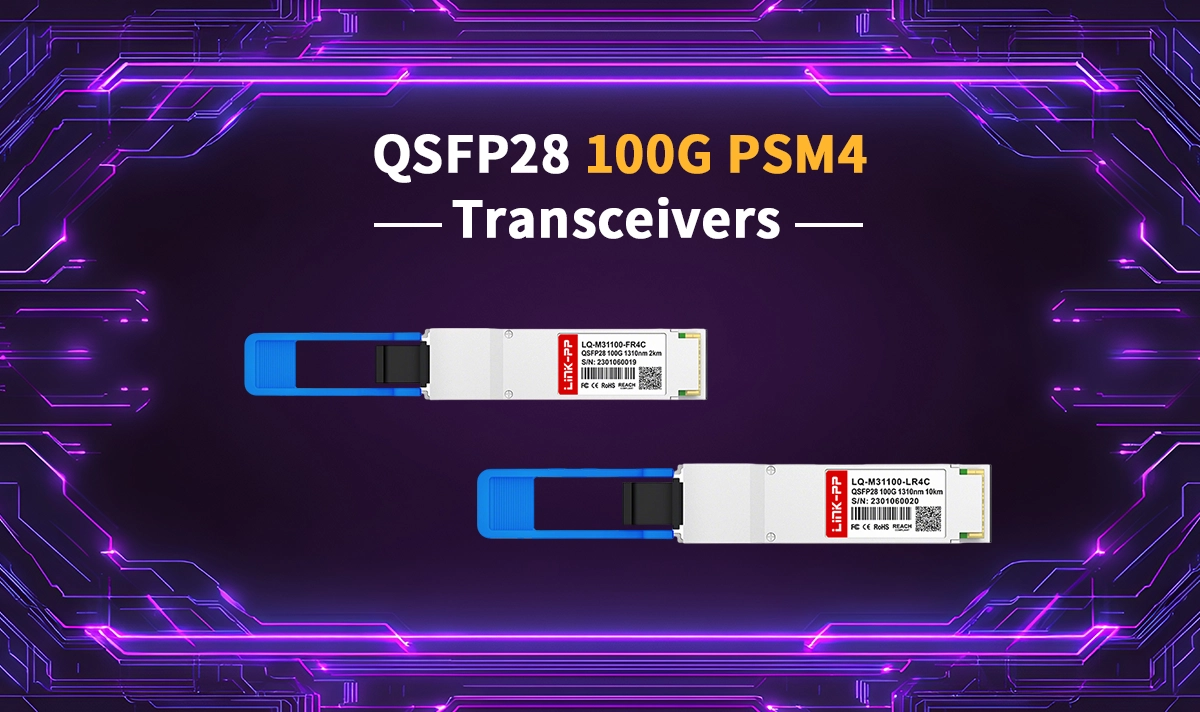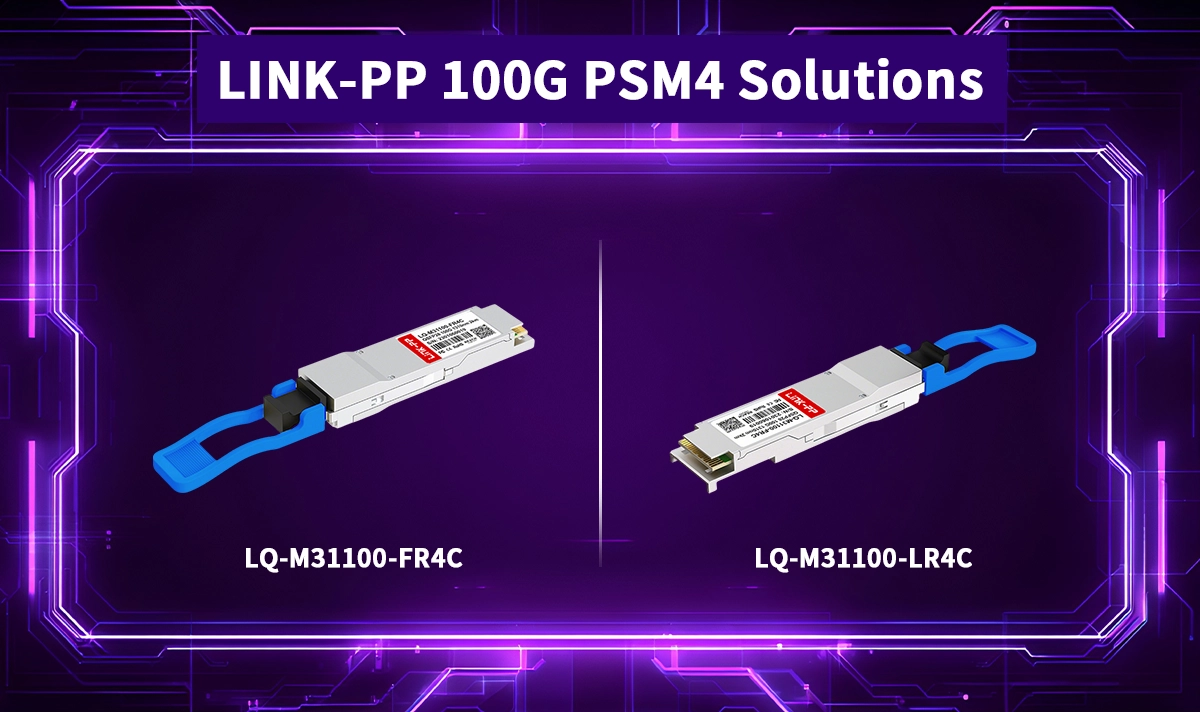
The relentless surge of cloud computing, AI, and hyperscale applications demands ever-faster, denser, and more cost-effective data center interconnects (DCI). Enter the 100G PSM4 (Parallel Single-Mode 4-lane) optical module – a crucial workhorse powering efficient 100 Gigabit Ethernet (100GbE) links. This guide dives deep into what makes PSM4 a vital solution for modern network infrastructure.
💡 Knowing about PSM4 technology helps network engineers pick the best choice for strong and growing performance.
📝 What is a 100G PSM4 Optical Module?
A 100G PSM4 transceiver is a pluggable optical module designed for 100G Ethernet transmission over single-mode fiber (SMF). It utilizes four independent optical lanes, each operating at 25Gbps (using NRZ modulation) at the 1310nm wavelength. Unlike 100G CWDM4 transceivers, which multiplexes wavelengths onto a single fiber pair, PSM4 requires eight fibers (4 Tx, 4 Rx) – a dedicated pair for each lane. This "parallel optics" approach offers distinct advantages.
📝 Key Advantages of 100G PSM4 Technology
Cost Efficiency: 💰 PSM4 leverages lower-cost optical components compared to wavelength-multiplexing solutions like CWDM4. The simpler optics translate into a lower-cost 100G transceiver, especially significant for large-scale deployments.
Low Latency: ⚡ The direct parallel transmission path minimizes signal processing complexity, resulting in ultra-low latency – critical for high-frequency trading, AI clusters, and financial applications.
High Density & Scalability: ⭐ PSM4 modules are typically QSFP28 form factor, enabling high port density on switches and routers. They are ideal for leaf-spine architectures and top-of-rack (ToR) to aggregation/distribution switch connections within a data center hall.
Reliable SMF Performance: 🚀 Utilizing proven single-mode fiber ensures longer reach potential (up to 500m, often 2km with quality modules like LINK-PP's) and superior performance compared to multi-mode solutions (like SR4) over similar distances.
📝 Ideal Applications for 100G PSM4 Modules
Data Center Interconnect (DCI): Within a single data center building or campus (up to 500m-2km).
High-Performance Computing (HPC) Clusters: Where low latency and high bandwidth are non-negotiable.
Enterprise Network Core/Aggregation: Upgrading backbone links for bandwidth-intensive applications.
Cloud Provider Infrastructure: Connecting servers, storage, and switches in large-scale cloud environments.
Financial Networks: Supporting low-latency trading platforms.
📝 PSM4 vs. CWDM4: Choosing the Right 100G SMF Solution
Feature | 100G PSM4 | 100G CWDM4 |
|---|---|---|
Technology | Parallel Optics (4 lanes) | WDM (4 wavelengths on 1 pair) |
Fiber Count | 8 Fibers (4 Tx, 4 Rx) | 2 Fibers (1 Tx, 1 Rx) |
Reach | Up to 500m (Common), 2km+ | Up to 2km |
Cost | Generally Lower | Higher |
Latency | Ultra-Low | Low |
Complexity | Lower (Optics) | Higher (WDM Mux/DeMux needed) |
Best For | High-density, cost-sensitive intra-DC links <2km | Links where fiber is scarce, up to 2km |
📝 Why Choose LINK-PP 100G PSM4 Optical Modules?

When reliability, performance, and value are paramount, LINK-PP stands out. Our 100G PSM4 QSFP28 transceivers are engineered for excellence:
Guaranteed Compatibility: Rigorously tested for seamless operation with major OEM switches (Cisco, Juniper, Arista, etc.). Avoid the risks of generic modules.
Superior Quality & Reliability: Manufactured to the highest standards, ensuring low bit error rates (BER) and long operational life – perfect for mission-critical data center links.
Extended Reach: Our LINK-PP LQ-M31100-FR4C model reliably achieves up to 2km over single-mode fiber, offering greater deployment flexibility.
Cost Savings: Experience significant CAPEX reduction without compromising on performance or stability.
Comprehensive Warranty & Support: Backed by industry-leading support and warranty.
Unlock Your 100G Potential with LINK-PP!
Optimize your data center fabric with high-performance, cost-effective 100G connectivity. Whether you're deploying new infrastructure or upgrading existing links, LINK-PP's 100G PSM4 transceivers provide the reliable, low-latency foundation you need.
Ready to explore LINK-PP 100G PSM4 Modules ?
➡️ LQ-M31100-FR4C (2km)
➡️ LQ-M31100-LR4C (10km)
📝 FAQ
What does PSM4 stand for?
PSM4 means "Parallel Single Mode 4-lane." The transceiver uses four fibers to send data. It also uses four fibers to get data. Each lane moves 25 Gbps.
Can QSFP28 100G PSM4 work with existing single-mode fiber?
Yes, QSFP28 100G PSM4 transceivers work with normal single-mode fiber (OS2). Many data centers already use this fiber type. This makes upgrades easy and saves money.
How do you monitor the health of a PSM4 transceiver?
Network managers use Digital Diagnostic Monitoring, called DDM. DDM shows things like temperature, voltage, and signal strength. This helps them spot and fix problems early.
What connector does the QSFP28 100G PSM4 use?
The transceiver uses an MPO/MTP-12 connector.
This connector holds twelve fibers in one row.
Eight fibers move data, and four are not used.
Is QSFP28 100G PSM4 hot-pluggable?
Yes, you can put in or take out the transceiver without turning off the device. This helps the network keep working during upgrades or repairs.
See Also
Explore 100G QSFP28 Optical Transceivers: SR4, LR4, CWDM4, PSM4 & More
PSM4 vs. CWDM4: What is the differences?
100G Single Lambda vs 4 Wavelength Optical Modules Key Differences
100G Optical Transceivers Form Factors: QSFP28, CFP, CFP2, CFP4?




